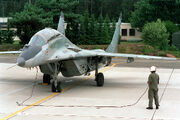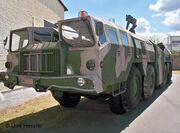Previous: Problem Stated
What Happened to the East German Army?[]
The East German army was called NVA, Nationale Volksarmee. On 3 October, 1990, the size of the land forces, the Navy and the Air Force combined was 88 thousand, including 23 thousand officers and 23 thousand non-commissioned officers.

Soviet MiG-29 used by the German Air Force after unification
Reddit writes in 2015:“Although the new Bundeswehr (the West German army) accepted some 20000 NVA personnel for the Armee der Einheit (Army of Unity), most of them were specialists or other individuals that could maintain the little Soviet equipment that Bundeswehr elected to keep. NVA officers above Oberstleutnant were particularly not welcome in the new German army as the Bundeswehr felt that these individuals had been ideologically compromised by the regime. Evidence of Stasi collaboration also became grounds for dismissal and the end of their careers. The NVA was very top-heavy in terms of officers, with an officer to enlisted ratio of 1:8, whereas the Bundeswehr maintained a ratio of 1:40. As such, the few NVA officers that remained in the Bundeswehr were dropped to the enlisted ranks as the Bundeswehr establishment saw NVA officers as performing the same functions as a Bundeswehr NCO. By about 2002, only about 5 percent of the Bundeswehr consisted of former NVA personnel.”
Hence, we see the West German army "accepting" a considerable chunk of the East German army, even though many of these officers were demoted a rank or two. Especially welcome were those specialist who could maintain the high-tech Soviet equipment which the West German army chose to keep.
Wikipedia writes:
"Retired NVA soldiers and officers received only minimal pensions after unification: a thirty-year veteran would receive a pension smaller than a graduate-student stipend. After the reform of 2005, service in the NVA became known as "served outside of the Bundeswehr".
Many former NVA officers feel bitter about their treatment after unification. While receiving only minimal pensions, few have been able to find jobs except as laborers or security guards. Former NVA officers are not permitted to append their NVA rank to their name as a professional title; no such prohibition applies to rank attained in the Wehrmacht or in the Waffen-SS during the Nazi era”.
The German state is more amicable to the former Nazis than to the former officers of the NVA. How far is the new "Fuhrer"?
“Country-data” writes about “Integration of East German Armed Forces”:
“Although the NVA's weapons and vehicles were maintained at a high level of operational readiness, signs of deterioration and personnel preparedness in manpower were evident even before the opening of the Berlin Wall in November 1989. Once the Wall opened, many reservists and some conscripts fled the country, disappearing into West Germany. Authority and morale declined as ordinary soldiers rebelled against strict discipline and military exercises. When soldiers' councils sprang up, NVA commanders bowed to pressure to allow soldiers to wear civilian clothes off post and enjoy relaxed discipline, reduced training time, and an end to political indoctrination. The morale of officers facing the loss of careers and status began to waver as the internal situation worsened and the prospect of unification grew”.
Here, we notice “soldiers’ councils” being mentioned, a clear sign of a revolutionary situation, or vacuum of power.
“Until mid-1990 the leadership of the NVA still hoped that the force might survive as a distinct entity in a reconstituted German state. As a result of the summit agreement between West German chancellor Helmut Kohl and Soviet president Mikhail Gorbachev in July 1990, however, the Soviet Union withdrew its objections to a united Germany's membership in NATO.”
So, the NVA officers, until the final months before unification, hoped to preserve the East German army intact, hoped for some kind of deal, whereby there would be in fact two states, two armies, all under the heading of "unified Germany". Perhaps, they had in mind something like "European Union", which consists of several distinct states, with separate armies.
“On October 3, 1990, the date of unification, control over all NVA commands and border troops passed to the newly created Bundeswehr Eastern Command. The command's function was to deactivate unneeded units, to dispose of surplus matériel and weapons, and to extend support to the withdrawing Soviet forces. The command was terminatedafter nine months, and the various elements of the former NVA were transferred to the three chiefs of staff and the medical service corps of the Bundeswehr.
The 90,000 NVA service personnel and 47,000 civilian employees who remained were merged into the Bundeswehr on a preliminary basis. It was decided that up to 50,000 of the former NVA troops would be retained as part of the Bundeswehr. Of 14,600 NVA officers, 5,100 were permitted to enter the Bundeswehr for a transition period of two years. Some 70 percent of these--mostly junior officers--would be retained after approval for regular Bundeswehr service and screening to eliminate former members of East Germany's State Security Service (Staatssicherheitsdienst--Stasi). Many of the 25,000 NVA enlisted personnel were assigned to a three-month basic training course with West German units”.
So, a large part of the East German army "merged" into the West German army, including 1/3 (5100 out of 14600) officers, and more than 1/2 of soldiers.
A campaign was started to indoctrinate the officers and soldiers to the values of the ruling class of FRG:
“A major effort was needed to instill democratic principles of leadership and a new perspective on historical and political questions. NVA officers had been indoctrinated with communist beliefs and had been considered among the most politically reliable elements of the East German state. Although forced to acknowledge that Marxist theories had diverged from social and economic realities in East Germany, many still tended to view communism as a valid, if utopian, political philosophy.”
“During a transition period, the brigades operated Soviet BMP armored vehicles, but Soviet tanks were replaced by Leopards. In the air force, the division at Eggerdorf controlled two fighter wings of Phantom F-4Fs and Soviet MiG-29s, with the Soviet aircraft to be gradually reduced in number. The former East German naval base at Warnemünde on the Baltic Sea was developed as the home port for fast-attack missile craft.”
“Large quantities of East German weapons were turned over to the Bundeswehr, including 2,300 main battle tanks, 7,800 armored vehicles, 2,500 artillery pieces, 400 combat aircraft, fifty attack helicopters, and many missile and rocket systems. More than 300,000 tons of ammunition had been stockpiled. With exceptions that included MiG-29s, BMP infantry fighting vehicles, and some transport helicopters, the Bundeswehr decided against trying to integrate former NVA weapons into its inventory. Ceilings imposed by the CFE Treaty, as well as problems of convertibility and safety, ruled out the wholesale absorption of the weapons.”

A decoy from the Deception center at Storkow.
Treaty on Conventional Armed Forces , negotiated during the Gorbachev era, and hence was forced to get rid of most of the Soviet equipment. Among things it chose to keep was a Deception center in Storkow, Brandenburg. The center is operated by former officers of NVA.
So, we notice that the most technologically advanced forces of the NVA, including equipment and officers, were made use of by the West German army. A large part of the junior officers and soldiers were integrated into the "Army of Unity". They were indoctrinated into West German values. Those officers who were retired received small pensions from the West German state.
Hence, we cannot say that the East German army was destroyed. Rather, an attempt was made to integrate the most technologically advanced parts of it into West German army. How successful this was remains to be seen.
Next: What Happened to the East German Security Police (Stasi) and the Internal Police?